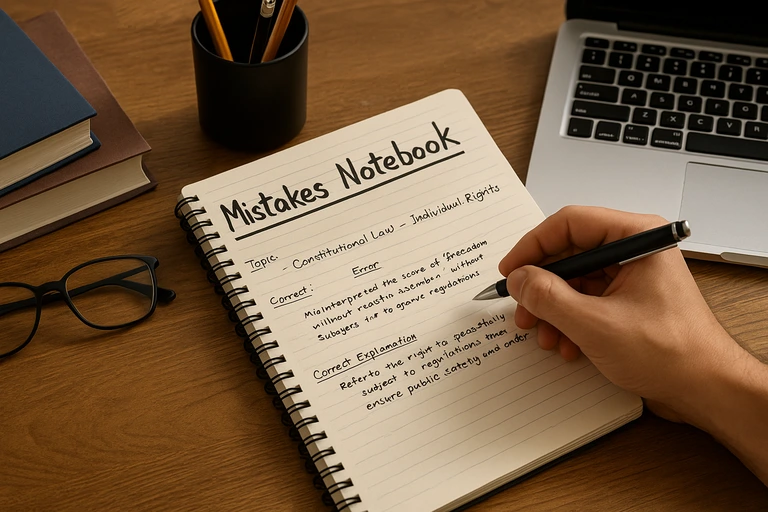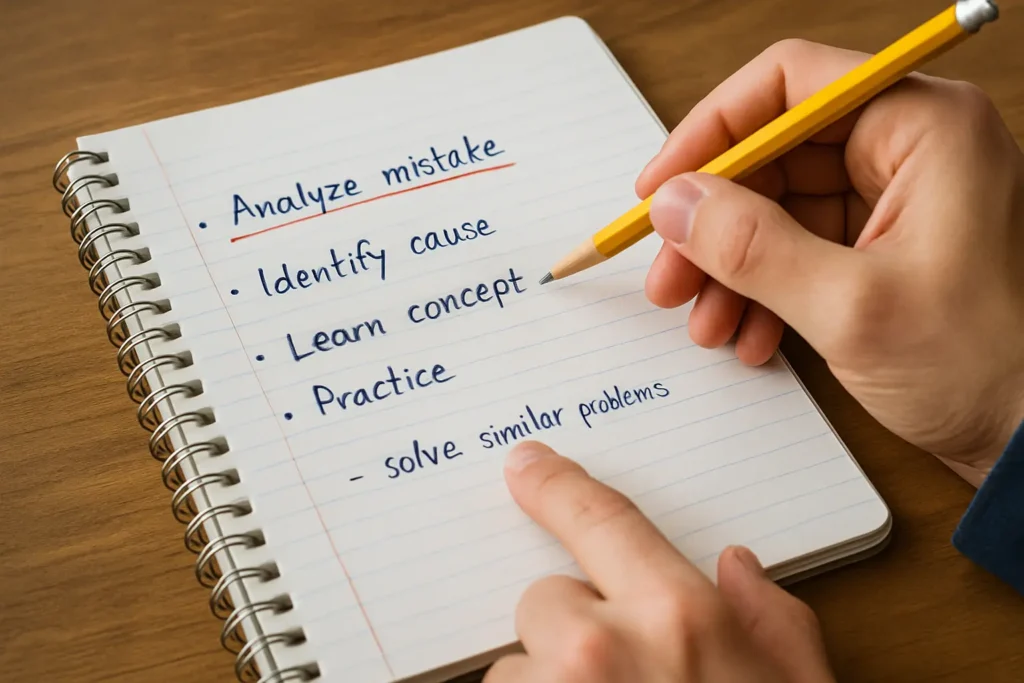
In the journey of exam preparation, one of the most underestimated tools is the mistake notebook. Many students focus on watching more classes, solving more questions, or organizing daily plans. But few realize that what you do with your mistakes can be far more important than how much new content you consume.
A mistake notebook, when used properly, becomes a personal learning tool. It not only helps you track what went wrong, but also allows you to understand why it went wrong and how to avoid repeating the same errors in the future. Rather than seeing mistakes as something to forget, this method turns them into an essential part of your success strategy.
Instead of feeling frustrated or discouraged when you answer questions incorrectly, this approach invites you to reflect, analyze, and correct the root of the problem. Over time, your notebook becomes a map of your progress — not just a collection of errors, but a record of how you overcame them.
Understanding the Real Purpose of a Mistake Notebook
Many candidates misunderstand what a mistake notebook is for. It’s not a place to copy entire questions or to simply highlight wrong alternatives. Its true value lies in how it helps you process your mistakes, not just register them.
When you write about what went wrong, your brain is forced to revisit the moment of confusion. This act of reflection leads to a deeper understanding of the concept you misunderstood. Instead of just knowing the right answer, you begin to comprehend the reasoning behind it — and that kind of learning is much harder to forget.
Additionally, keeping a mistake notebook increases your awareness. It reveals patterns in your thinking, shows which subjects need more attention, and helps you manage your study time better. You stop treating your preparation as a random effort and begin to act with more clarity and direction.
How to Start Building Your Notebook
Creating your mistake notebook doesn’t require fancy tools or a perfect format. It can be a physical notebook, a simple digital document, or a more organized app like Notion or Evernote. What matters most is consistency and ease of access. If the tool is too complex or slow, you won’t stick with it.
After each practice session or mock exam, take a moment to reflect on what didn’t go well. Choose the most important mistakes — not necessarily all of them — and write a short explanation of what you misunderstood. It’s not about volume; it’s about insight. You don’t need to copy the whole question. Summarize the topic, describe your reasoning, and explain the correct logic in your own words.
Try to be as clear as possible. Writing “got it wrong” or “confused this topic” isn’t enough. Be honest with yourself. Were you tired and rushing? Did you misread the question? Did you think you remembered a rule but applied it incorrectly? The more specific your notes, the more useful they will be when you come back to review them.
Reviewing Mistakes with Intention

Keeping a mistake notebook is only helpful if you revisit it regularly. Just like any other material, it won’t do you any good if it stays closed or buried in a folder. What sets this method apart is that it offers targeted revision based on your real performance, not just theoretical content.
Schedule time in your week to go back and read your previous entries. This doesn’t have to take long. Even 20 or 30 minutes can help reinforce the corrections and make sure the same mistakes aren’t repeated. In fact, the more frequently you review, the more likely you are to turn weaknesses into strengths.
You’ll start noticing that certain types of errors disappear from your recent notes — a clear sign that your review process is working. And if some mistakes keep reappearing, that’s a signal to dig deeper into that subject. It’s not about being perfect. It’s about reducing the frequency and severity of your errors over time.
When a Mistake is More Than Just a Mistake
Some mistakes reveal more than a gap in knowledge. They can be signs of deeper issues, such as poor exam strategy, lack of attention, stress, or even emotional resistance to certain topics. For example, you might consistently miss questions not because you don’t understand the subject, but because you panic when you see a certain format.
Your mistake notebook can help you identify these emotional and psychological patterns as well. You may begin to notice that you make more errors when you’re tired, when the question is framed in a certain way, or when you rush through the instructions. These insights are invaluable, and they allow you to address not just the academic side of preparation, but also the mental and behavioral one.
Studying isn’t just about knowledge. It’s about behavior, focus, and self-awareness. And the mistake notebook is one of the few tools that brings all of these elements together in a single place.
Building a Mindset of Learning Through Error
Many candidates avoid looking at their mistakes because it makes them uncomfortable. There’s a fear of facing failure, a feeling of shame, or even a belief that repeating what you did wrong will only make things worse. But the opposite is true. When you face your errors with curiosity instead of judgment, they become stepping stones.
The most successful students are not the ones who never make mistakes — they are the ones who learn the most from their mistakes. This mindset shift is what allows you to progress faster and more efficiently than someone who simply keeps repeating the same study habits, hoping for different results.
By embracing a process of review and reflection, you create a learning loop: study, apply, analyze, correct, reinforce. That loop is far more powerful than passively reading or re-watching a class. And over time, it builds not only knowledge, but confidence.
Final Thoughts: Your Mistakes Are Your Best Teachers
In a world where students are encouraged to focus only on right answers, it can feel counterintuitive to create a notebook full of wrong ones. But when used with intelligence, your mistake notebook becomes one of the most important parts of your preparation.
It shows you where to improve. It helps you avoid repeating errors. It deepens your understanding and sharpens your judgment. And more than that, it shows that you’re committed to genuine learning, not just performance.
So don’t hide your mistakes. Organize them. Study them. Learn from them. Let your errors guide you toward the result you want — not as something to fear, but as the very thing that will make you stronger.